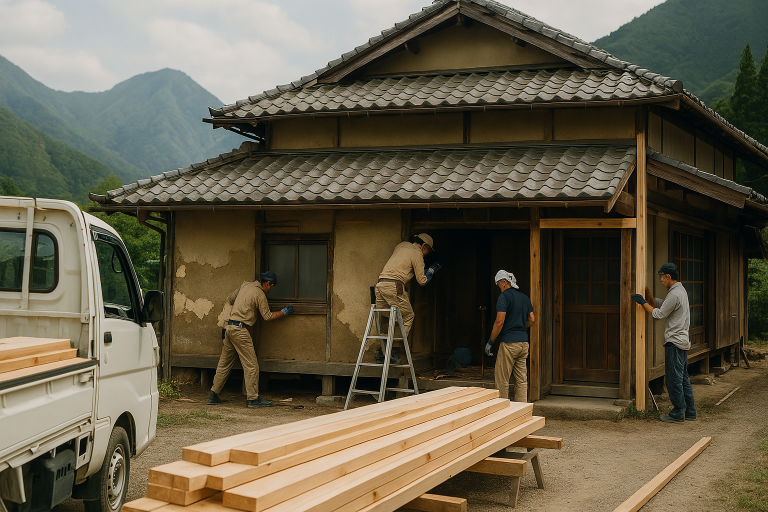TL;DR:
- New regulations from April 2025 tighten rules on major renovations.
- Minor renovations under 50% of structural alterations avoid complex permits.
- Non-compliance carries significant legal and financial risks.
- Strategic planning and professional guidance ensure smooth, compliant renovations.
Thinking of renovating an older property in Japan? You’re not alone—many homeowners see great potential in the affordable “akiya” (vacant homes) scattered across rural and suburban Japan. However, these properties, often left unoccupied for years, frequently require substantial renovations to become liveable again. Starting in April 2025, new updates to Japan’s Building Standards Act will directly impact these renovation plans. This article details what these changes mean, how to remain compliant, and offers strategies to renovate smartly without excessive bureaucracy.

What are Japan’s 2025 Building Standards Act Amendments?
Beginning in April 2025, significant amendments to Japan’s Building Standards Act will clearly define “major renovations” and introduce stricter requirements related to earthquake safety, energy efficiency, and sustainability.
Major Changes in Japan’s Home Renovation Rules for 2025:
- Renovations impacting over 50% of principal structural components (walls, foundations, frameworks) will require detailed permits and adherence to updated earthquake resistance and energy efficiency standards.
- New energy conservation standards mandate at least Thermal Insulation Performance Grade 4 and Primary Energy Consumption Grade 4.
- Adjusted structural calculation standards for wooden buildings will impact renovation approaches.
Why is Japan Updating its Building Renovation Laws?
The core objectives are:
- Improving earthquake safety due to Japan’s frequent seismic activity.
- Promoting energy efficiency to reduce environmental impacts and lower household energy costs.
- Supporting sustainable development to ensure safer, healthier communities.
These laws primarily target substantial renovations, providing flexibility for smaller, incremental projects.
How 2025 Renovation Laws Impact Owners of Akiya (Vacant Houses)
Many akiya were built or last renovated before current building codes, classifying them as “Existing Non-Conforming Buildings.” According to Article 3, Paragraph 2 of the Building Standards Act:
“If buildings which are already existing… do not conform to current standards… the relevant provisions shall not apply… unless significant construction work—such as additions, rebuilding, major repairs, or remodeling—is undertaken.”
In practical terms, this means minor renovations and regular maintenance of akiya typically won’t trigger full compliance requirements. However, extensive renovations exceeding the 50% structural threshold will require adherence to current standards.

Why Structural Inspections Are Crucial Before Buying an Akiya in Japan
Carefully inspecting properties for structural deterioration before purchasing is critical. Many akiya, especially those left vacant for extended periods, can suffer from hidden structural issues such as poor foundations, rotten beams, or compromised roofs. A detailed inspection can reveal these problems upfront, allowing you to understand potential renovation costs and compliance complexities clearly. This proactive step helps avoid unexpected expenses and extensive renovation demands that may surpass the 50% threshold.
Renovation Costs and Challenges for Japanese Homes Built Before 1981
Homes constructed before the 1981 building code revisions often lack adequate earthquake-resistant features, making renovations potentially more complex and costly if significant structural damage exists. Upgrading these older structures to meet modern earthquake resistance standards can significantly increase renovation expenses. Being aware of a property’s construction year and structural condition can guide informed decisions and help manage expectations regarding renovation costs and compliance obligations.
Using Inspection Results to Negotiate Lower Property Prices in Japan
The information obtained through thorough inspections and understanding structural conditions—particularly in older homes or those built before the 1981 building codes—can be effectively used during negotiations. Awareness of potentially costly renovation requirements can give buyers leverage to negotiate a lower purchase price, reflecting the investment needed to bring the property up to current safety and energy efficiency standards. Knowledge of these details can ultimately lead to significant savings and informed property investments.
How to Renovate a Home in Japan Without Major Permits
Smart strategies can help homeowners renovate effectively without triggering extensive permits:
- Minor Updates: Cosmetic enhancements (painting, flooring, and interior fixture updates).
- Non-structural Repairs: Small-scale roof and exterior maintenance below the 50% structural threshold.
- Phased Renovations: Breaking extensive projects into smaller, spaced-out phases under the 50% threshold.

Important Legal Definitions from Japan’s Building Standards Act:
Article 2 (Definitions):
- Construction: “To newly construct, add, rebuild, or relocate a building.”
- Major Repair: “Repair of a building exceeding 50% of principal parts.”
- Major Remodeling: “Remodeling of a building exceeding 50% of principal structural components.”
Article 3 (Exemptions):
- Buildings designated as national treasures or cultural properties are exempt.
- Existing non-conforming buildings can remain unless undergoing significant renovations.
Article 6 (Permit Requirements):
- Major renovations require confirmation from designated inspection authorities.
Effective Strategies to Stay Compliant with Japan’s Renovation Laws:
- Assess structural components thoroughly to avoid unintended major renovations.
- Plan renovations incrementally and clearly document each phase.
- Engage professionals (architects, legal experts) familiar with Japan’s building codes.
- Communicate proactively with local authorities to clarify uncertainties.
Best Practices for Compliance in Japanese Home Renovations:
- Keep comprehensive renovation records (plans, invoices, photos).
- Consult regularly with local inspection bodies and building offices.
- Stay informed on ongoing legal revisions and requirements.
Risks and Consequences of Non-Compliance with Japan’s Renovation Laws:
- Legal penalties, fines, and mandatory compliance orders.
- Reduced property market value and resale difficulties.
- Safety risks associated with non-compliant renovations.
Successfully Navigating Japan’s 2025 Home Renovation Laws: Final Thoughts
The 2025 amendments to Japan’s Building Standards Act introduce stricter guidelines but still allow homeowners ample flexibility through strategic renovation planning. Understanding and carefully navigating these regulations can ensure successful home renovations that enhance property value, safety, and sustainability.

